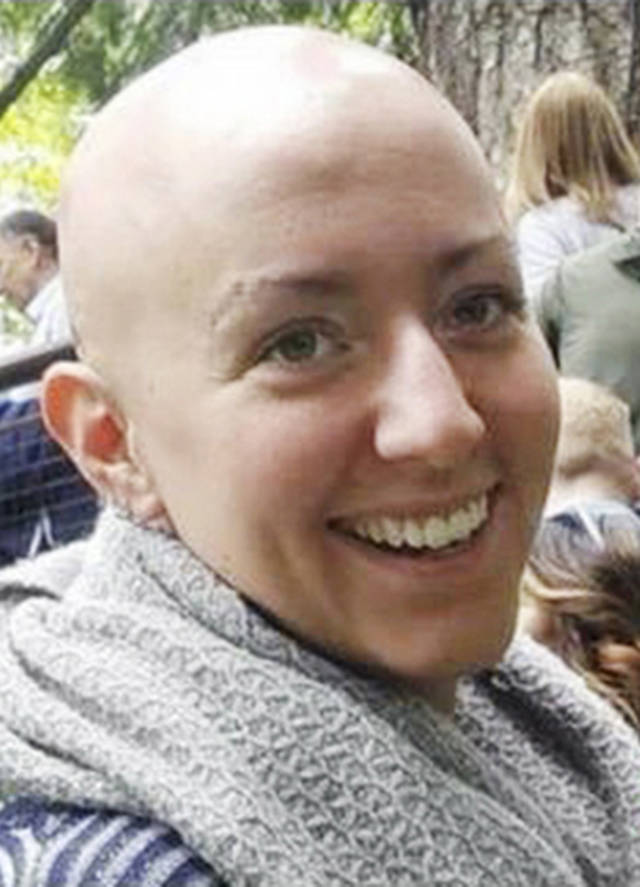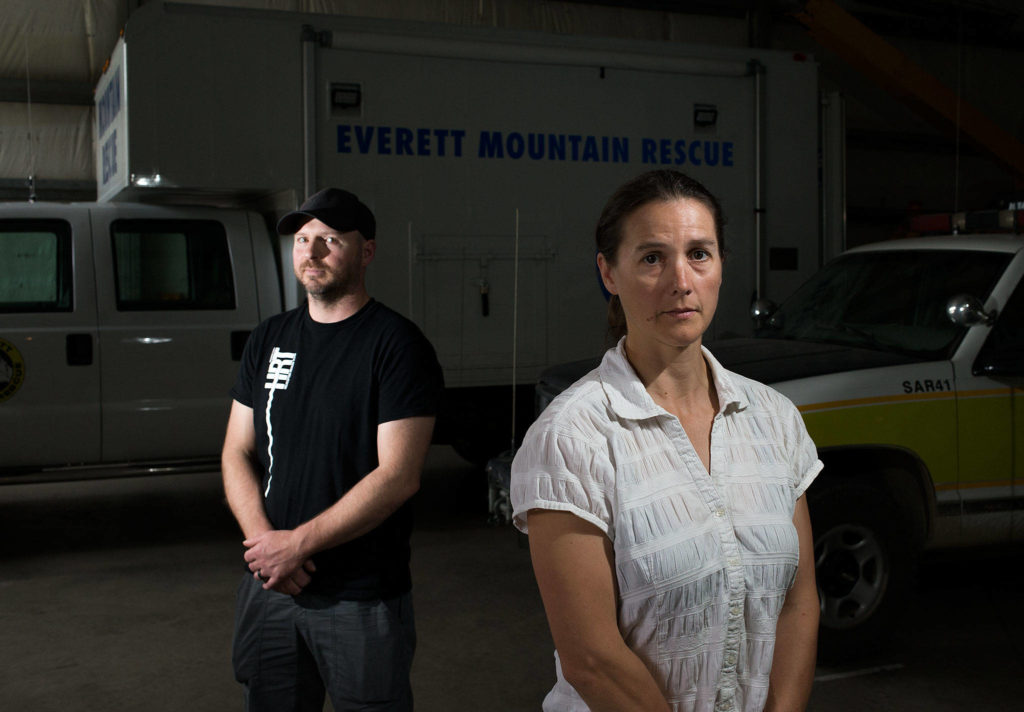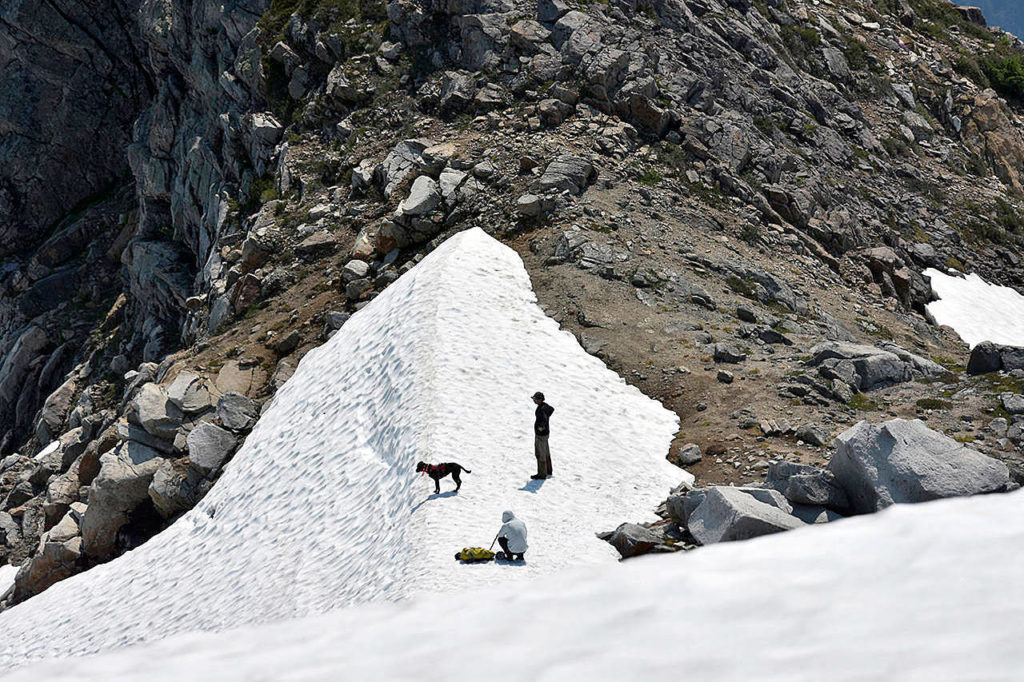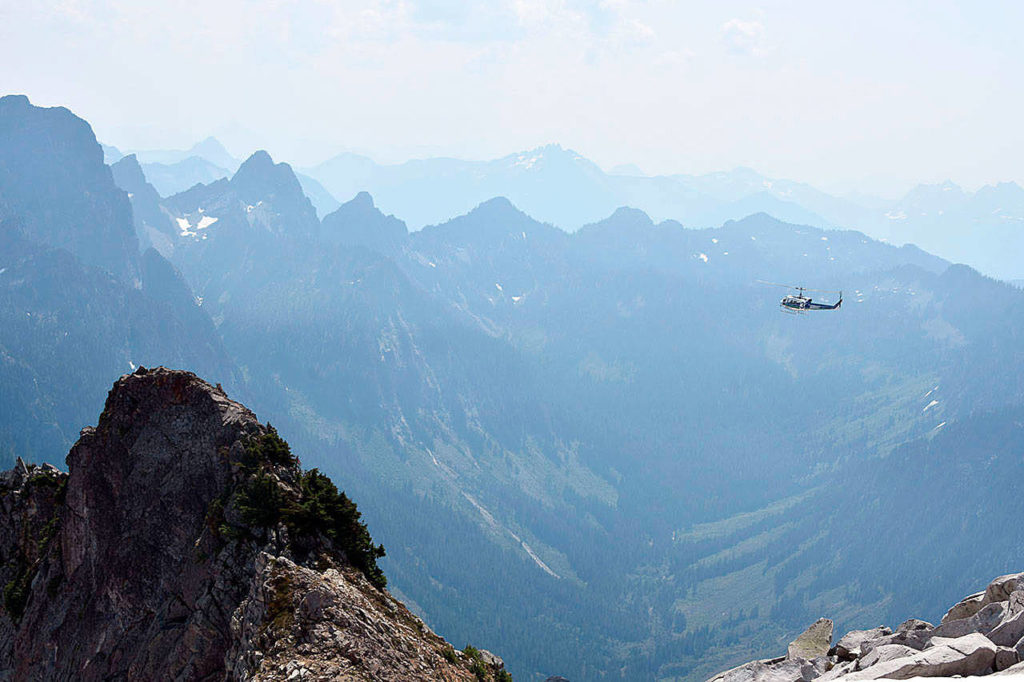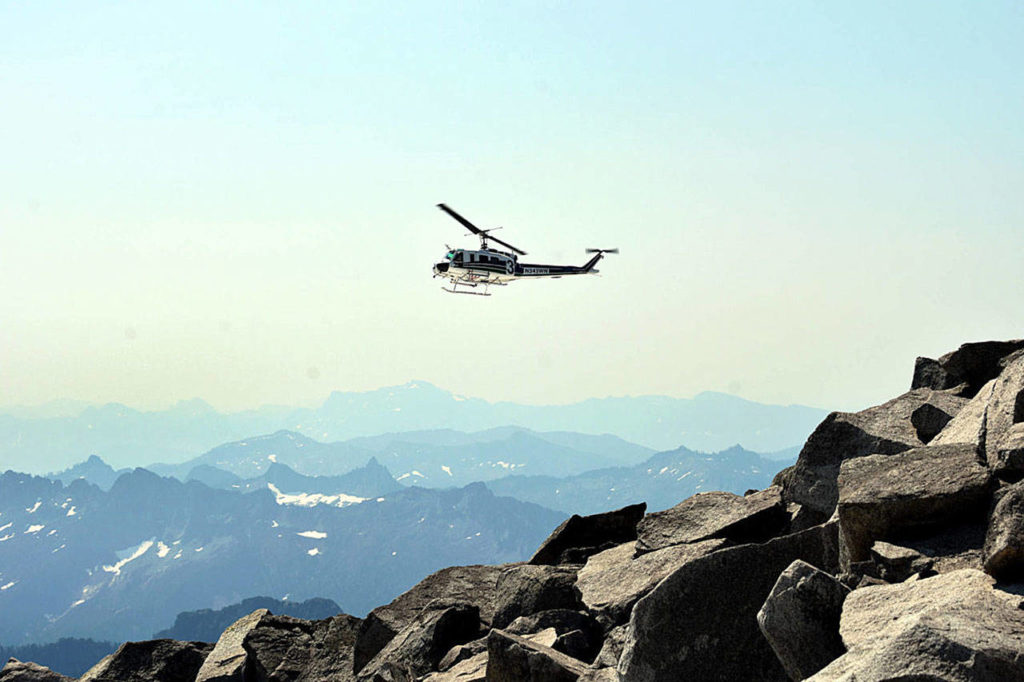VERLOT — If they could move the mountain for her, they would.
Family, friends and strangers have tried almost everything else to find Samantha Sayers, the Seattle day hiker who was last seen the afternoon of Aug. 1, at the summit of Vesper Peak.
A team led by her boyfriend’s father — a Black Hawk pilot and a chief warrant officer with the National Guard — launched a renewed search this week, packing and flying in gear for a base camp. They’ll scour the wilderness as long as it takes to bring Sayers home, or the snow makes it impossible to stay on the 6,220-foot peak. They’re asking trained mountaineers to join them, as well as hikers who can volunteer to be pack-mules.
Efforts to find Sayers, 28, have been exhaustive.
An official search wore on for three weeks, beginning at 1 a.m. Aug. 2. The Snohomish County Sheriff’s Office logged 868 hours of time from the air, ground and water. Yet the vast majority of the search was carried out by hundreds of “unpaid professionals” — climbers, hikers, pilots and dog handlers from across the state.
New figures show volunteers donated 7,904 hours of their time. The total number of hours spent searching was greater than the hours in a year.
First days
One of the first on the mountain was Joe Edmark. He’d spent his morning at work, at a commercial bakery. Once his shift ended, he answered the call on his pager and headed up the Mountain Loop Highway. The trailhead is a 100-minute drive northeast of Seattle. He was on the trail Aug. 2, within hours of the last sighting. Nothing seemed odd to Edmark, that first day. Everett Mountain Rescue crews did what they always do, playing the percentages, looking in the most logical places.
First, they traced the trail to the summit, and all around the peak.
No sign of Sam.
Next, the creeks. They clambered down the drainage of a lake known both as Elan and Vesper. It’s the outlet of a bowl of glaciated rock, a half-mile wide between Vesper and Sperry peaks. The main trail to Vesper’s summit is a challenge. Below the lake, it’s a technical off-trail climb. You can’t just have dozens of people link arms, walk through the forest and cross off every possibility on a grid. It’s not that kind of place.
“It’s super rugged, it’s dangerous, it all falls into the creek,” Edmark said. “There’s a couple of 100- to 200-foot waterfalls, (and slopes of) probably 40, 50 degrees, in slippery blueberry bushes, pine needles. We had to keep looking at the topography, to find a way to actually keep going down. You could slip at any point. We had to route-find to get through it. It’s not anything that, typically, a hiker’s going to walk down.”
They shouted Sayers’ name in all directions.
“We’re not checking every tree, bush, rock,” Edmark said. “That’s impossible. When you have somebody who’s not going to return a call, all of a sudden your search area becomes this small — it’s the size of a person.”
Out there, anything unusual sparks a searcher’s interest. Teams uncovered a mylar balloon, and metal artifacts from the mountain’s mining history. But no sign of Sam.
Edmark has searched with Everett Mountain Rescue since 2011. He responds to 25 to 30 calls per year, when people are hurt or missing. These are people like him, he said, who share his love of the outdoors.
Years ago Edmark snapped his leg on a solo climb of Mount Rainier. He splinted the fracture, called for help with a locator beacon and for the rest of the night he was blinded by flashing headlamps in a 19-hour ground rescue. This is how he gives back. He has read the posts on Facebook pages like #findsamsayers, where 33,000 people follow the missing hiker’s story.
“You sort of feel like you’re being judged by your own people at some point,” he said. “‘Why didn’t they go there? Why did they quit? Why aren’t they still out there?’ We’d love to have closure, dead or alive, and bring somebody back to their family. We’re usually able to do that.”
Of all the popular day hikes in the state, Vesper is among the toughest. A path switchbacks boulders in Wirtz Basin, threads Headlee Pass and scrambles rock and snowfields, to a jagged summit.
Searchers risked death, gazing into crevasses that Sayers could have slipped into. On the north face are moats that skilled climbers can’t reach. Trekking poles or an ice ax is needed to reach the top, even in August. None of Sayers’ gear has been found. She took her poles that day. Since then, snow has melted. Alpine summer is ending.
“There’s places on that mountain, if someone were to fall, they’re never going to be found,” Edmark said. “I think if Sam Sayers was alive on Vesper Peak, we would’ve found her.”
First weeks
Sayers was living in Belltown. She worked at the Seattle Repertory Theatre, ran an online store for new moms and dabbled in real estate with her boyfriend, Kevin Dares. They’d dated for two years, exploring the Cascades and the Olympics at every chance. Sayers had climbed Vesper many times. The story of how she went missing has been retold in local and national media. Her photo stood out: She has baldness from alopecia. She packed sandwiches and warm clothes, but no overnight gear.
One group saw her hiking to the summit. Climbers saw her at the top around 2 p.m. No one saw her come down. She didn’t check in as planned around 6 p.m. Dares drove up the Mountain Loop to look for her that night, he said. Her Ford Fiesta remained at the trailhead. He set out on the dark trail, but slipped, broke a flashlight and retreated to a ranger station, he said.
For weeks, helicopters circled the peaks and valleys. Ground teams and dogs fanned across rugged terrain. Weeks into the search, Elaina Jorgensen rode a helicopter to a snowy ridge north of the peak, above Copper Lake. Her team searched the base of a 1,000-foot drop. She looked up. As a terrible skier, Jorgensen said, she knows if someone crashes on a snow slope, stuff will go flying.
“We discussed this as a team,” said Jorgensen, president of the Everett Mountaineers. “You’re not going to make it down without gear going everywhere, and if she ended up in one of those moats, she would almost have to have left a trail, that they would have seen that first day.”
They hoped to find clothing, or a pole, or something. Her team picked up old carabiners, the tiniest traces of rock climbers.
“Imagine something that falls a thousand feet, and it’s this big,” Jorgensen said, making a shape smaller than a palm. “And you’re able to find it, but you’re not able to find trekking poles? Or a backpack? Or a sweatshirt? Or a body. There was no animal activity. No birds. It was just weird.”
They inspected snow bridges. Cadaver dogs were brought in, to alert searchers to a human scent. On her phone Jorgensen snapped a photo of a crevasse, a bluish mouth of ice, and blackness with no visible bottom.
“It did get to the point where we aborted, because it was just too dangerous,” she said.
Jorgensen has been lost in the woods, in her early 20s. She did everything she wasn’t supposed to do, she said, but somehow rediscovered a trail. She has underestimated snow before. Those moments were like warning shots, telling her she needed to pack the essentials, even on day hikes.
If she faces a risk in the mountains, she asks herself if she’s willing to spend the night there. If the answer is no, she turns back.
“The problem we have in the Pacific Northwest is everything is so accessible, and everything is right there, and all your friends are doing it, and you see it on social media, and they make it look so easy,” Jorgensen said. “But everything’s fine, until it’s not fine.”
Coming weeks
Sayers’ fiancé, Kevin Dares, spent many of the past 43 mornings on Vesper Peak. He has covered nearly every inch of ground that’s not in the trees, and a good share of the forest, he said.
“In the beginning I was alone out there,” he said. “That’s a tough place to be alone, because you’re with your thoughts.”
Support has come from across the globe, via the internet. Dares and others have posted drone footage to YouTube, to show all angles of the mountain, from passes to basins to the summit.
Some videos have been viewed more than 10,000 times, as people watched frame-by-frame, with a crowdsourced spreadsheet to mark any evidence of Sayers. In late August, someone spotted a violet jacket in one video. It had been caught on a branch in a fern-covered slope. But it wasn’t Sam’s.
Other anomalies turned out to be rocks, shrubs or the movements of rodents.
Dares wants people to know his team is still going strong, even if the official search is suspended.
This week was a time to regroup in his Seattle living room, now a command center with walls covered in maps. They awaited shipments of gas generators and a giant canvas tent. They plan to stay on the mountain until the snow returns in October or November. About $50,000 has been raised online. About half of it has been spent on equipment, Dares said.
The team was waiting, too, for Dares’ father to arrive and take charge. Kevin Dares and his dad share a name, except the elder holds a rank of Chief Warrant Officer 5 in the Louisiana National Guard. He served on rescue missions after Hurricane Katrina. A supporting cast is made up of people who grew up in the Cascades.
Volunteers can contact FindSamSayers.infobox@gmail.com.
Sayers’ fiancé hopes to return to the mountain by Saturday. He knows the odds. He wants to keep up hope, but he understands the chances of finding Sayers alive are “beyond slim.”
“Whether Sam is with us or no longer with us, the mission is still the same,” he said, “to bring her home, no matter what that means.”
Caleb Hutton: 425-339-3454; chutton@heraldnet.com. Twitter: @snocaleb.
Talk to us
> Give us your news tips.
> Send us a letter to the editor.
> More Herald contact information.
